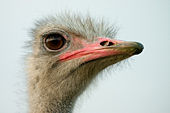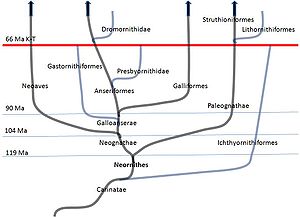- Modern birds
-
Modern birds
Temporal range: Early Cretaceous–Recent, 130–0 Ma
Ostrich, a paleognath 
Dolphin Gull, a neognath Scientific classification 
Kingdom: Animalia Phylum: Chordata Class: Aves clade: Carinatae Subclass: Neornithes
Gadow, 1893[1]Subgroups - †Gallornis
- Neognathae
- Palaeognathae
- †Palaeotringa
Modern birds (subclass Neornithes) are the most recent common ancestor of all living birds (class Aves) and all its descendants.
Modern birds are characterised by feathers, a beak with no teeth (ancient birds had teeth), the laying of hard-shelled eggs, a high metabolic rate, a four-chambered heart, and a lightweight but strong skeleton. All birds have forelimbs modified as wings and most can fly, with some exceptions including ratites, penguins, and a number of diverse endemic island species. Birds also have unique digestive and respiratory systems that are highly adapted for flight. Some birds, especially corvids and parrots, are among the most intelligent animal species; a number of bird species have been observed manufacturing and using tools, and many social species exhibit cultural transmission of knowledge across generations.
Many species of modern bird undertake long distance annual migrations, and many more perform shorter irregular movements. Birds are social; they communicate using visual signals and through calls and songs, and participate in social behaviours including cooperative breeding and hunting, flocking, and mobbing of predators. The vast majority of bird species are socially monogamous, usually for one breeding season at a time, sometimes for years, but rarely for life. Engagement in extra-pair copulations is common in some species; other species have breeding systems that are polygynous ("many females") or, rarely, polyandrous ("many males"). Eggs are usually laid in a nest and incubated by the parents. Most birds have an extended period of parental care after hatching.
Contents
Taxonomy
Modern birds are divided into two superorders; the Palaeognathae (tinamous and flightless ratites like ostriches), and the wildly diverse Neognathae, containing all other birds. Depending on the taxonomic viewpoint, the number of species cited varies anywhere from 8,800 to 10,200 known living bird species in the world. It is generally agreed that the Neornithes evolved in the Cretaceous Period and that the split between the Palaeognathae and Neognathae, and then the split between Galloanserae (fowl) and the other Neognathae, occurred before the Cretaceous-Tertiary (K-T) extinction event (the earliest fossil remains confidently referred to the Neornithes come from the Hauterivian age Gallornis straeleni[2]), but there are different opinions about whether the radiation of the remaining neognathes occurred before or after the extinction of the other dinosaurs.[3] This disagreement is in part caused by a divergence in the evidence, with molecular dating suggesting a Cretaceous radiation and fossil evidence supporting a Tertiary radiation. Attempts made to reconcile the molecular and fossil evidence have proved controversial.[3][4]
The classification of modern birds is a contentious issue. Sibley & Ahlquist's Phylogeny and Classification of Birds (1990) is a landmark work on the classification of birds, although frequently debated and constantly revised. A preponderance of evidence seems to suggest that the modern bird orders constitute accurate taxa. However, scientists are not in agreement as to the relationships between the orders; evidence from modern bird anatomy, fossils and DNA have all been brought to bear on the problem but no strong consensus has emerged. More recently, new fossil and molecular evidence is providing an increasingly clear picture of the evolution of modern bird orders. See also: Sibley-Ahlquist taxonomy and dinosaur classification.
In traditional classification, the Neornithes also included a third superorder, the Odontognathae, containing advanced toothed birds from the Cretaceous, like Hesperornis and Ichthyornis.[5] This superorder is likely paraphyletic, and fall outside the crown group birds. It is not entirely clear whether the Palaeognathae too are paraphyletic, or represent a primitve grade of birds.[6]
Classification
Aves Pygostylia Ornithothoraces Ornithurae †Hesperornithiformes
Neornithes Palaeognathae
Neognathae Galloanserae
Neoaves
Basal bird phylogeny showing Neornithes and extinct ancient groups (simplified after Chiappe, 2007[7]) This is a list of the taxonomic orders in the subclass Neornithes, or modern birds. The list of birds gives a more detailed summary of these, including families.
Subclass Neornithes
- Odontognathae (omitted under the crown group classification)
- Palaeognathae:
- Neognathae:
- Galloanserae:
- Anseriformes, waterfowl
- Galliformes, fowl
- Neoaves:
- Gaviiformes, loons
- Podicipediformes, grebes
- Procellariiformes, albatrosses, petrels, and allies
- Sphenisciformes, penguins
- Pelecaniformes, pelicans and allies
- Ciconiiformes, storks and allies
- Phoenicopteriformes, flamingos
- Falconiformes, falcons, eagles, hawks and allies
- Gruiformes, cranes and allies
- Charadriiformes, gulls, button-quail, plovers and allies
- Pteroclidiformes, sandgrouse
- Columbiformes, doves and pigeons
- Psittaciformes, parrots and allies
- Cuculiformes, cuckoos, turacos, hoatzin
- Strigiformes, owls
- Caprimulgiformes, nightjars and allies
- Apodiformes, swifts and hummingbirds
- Coraciiformes, kingfishers
- Piciformes, woodpeckers and allies
- Trogoniformes, trogons
- Coliiformes, mousebirds
- Passeriformes, passerines
- Galloanserae:
Note: This list is mostly based on the traditional classification (the so-called Clements order) - with the addition of the commonly accepted Galloanserae and Neoaves clades. A radically different classification based on molecular data has been developed (the so-called Sibley-Monroe classification or Sibley-Ahlquist taxonomy). Some of the proposals of the Sibley-Ahlquist taxonomy has influenced taxonomic thinking considerably, with the Galloanserae proving well-supported by recent molecular, fossil and anatomical evidence.[3] With increasingly good evidence, it has become possible to test some major proposals of the Sibley-Ahlquist taxonomy, with favorable results (see for example Charadriiformes, Gruiformes or Caprimulgiformes). However, many proposals of the Sibley-Ahlquist taxonomy are now discarded by most scientists, such as the lumping of many unrelated orders into a greatly enlarged Ciconiiformes.
Phylogeny
Basal divergences of modern birds based on the Sibley-Ahlquist taxonomy.
Neornithes Palaeognathae Struthioniformes
Tinamiformes
Neognathae Neoaves
Galloanserae Footnotes
- ^ Brands, Sheila (2009)
- ^ Hope, Sylvia (2002)
- ^ a b c Ericson, P. G. P., et al. (2006)
- ^ Brown, J., et. al (2007)
- ^ Romer, A. S. & Parsons, T. S. (1985): The Vertebrate Body. (6th ed.) Saunders, Philadelphia.
- ^ McDowell, Sam (1948). "The bony palate of birds" (PDF). The Auk 65 (4): 520–549. http://elibrary.unm.edu/sora/Auk/v065n04/p0520-p0549.pdf.
- ^ Chiappe, L. M. (2007)
References
- Brands, Sheila (17 Oct 2009). "Systema Naturae 2000 / Classification - Genus Phoebetria -". Project: The Taxonomicon. Amsterdam, The Netherlands: Universal Taxonomic Services. http://www.taxonomy.nl/Main/Classification/51486.htm. Retrieved 06 Feb 2011.
- Brown J., Payne B., Mindell D. (27 June 2007). "Nuclear DNA does not reconcile 'rocks' and 'clocks' in Neoaves: a comment on Ericson et al.". Biol Lett 3 (3): 1–3. doi:10.1098/rsbl.2006.0611. PMC 2464679. PMID 17389215. http://www.pubmedcentral.nih.gov/articlerender.fcgi?tool=pmcentrez&artid=2464679.
- Chiappe, Luis M. (2007). Glorified Dinosaurs: The Origin and Early Evolution of Birds. Sydney: University of New South Wales Press. ISBN 978-0-86840-413-4.
- Ericson P. G. P, Anderson C. L., Britton T., Elzanowski A., Johansson U. S., Kallersjo M., Ohlson J. I., Parsons T. J., Zuccon D., Mayr G. (22 December 2006). "Diversification of Neoaves: integration of molecular sequence data and fossils". Biol Lett 2 (4): 543–547. doi:10.1098/rsbl.2006.0523. PMC 1834003. PMID 17148284. http://www.pubmedcentral.nih.gov/articlerender.fcgi?tool=pmcentrez&artid=1834003.
- Hope, Sylvia (2002) "The Mesozoic Radiation of Neornithes" in Chiappe, Luis M. & Witmer, Lawrence M. Mesozoic Birds: Above the Heads of Dinosaurs pp. 339–388 ISBN 0520200942
Archosauromorphs Primitive
ArchosauromorphsPrimitive
ArchosauriformsCrurotarsi Archosaurs Avemetatarsalia and
Ornithodira ArchosaursAvian Archosaurs Avialae • Archaeopteryx • Confuciusornis • Ichthyornis • Enantiornithes • Hesperornithes • Neornithes • Palaeognathae • NeognathaeCategories:- Birds by classification
Wikimedia Foundation. 2010.


